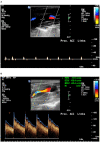Long-Term Sonographical Follow-Up of Arterial Stenosis Due to Spontaneous Cervical Artery Dissection
- PMID: 35185752
- PMCID: PMC8850833
- DOI: 10.3389/fneur.2021.792321
Long-Term Sonographical Follow-Up of Arterial Stenosis Due to Spontaneous Cervical Artery Dissection
Abstract
Purpose: Little is known about the long-term course of arterial stenosis after spontaneous cervical artery dissection (sCAD). We analyzed changes over time and evaluated factors potentially associated with these changes and recurring sCAD.
Materials and methods: Adult patients with sCAD, admitted to our neurological department between 2004 and 2018, were included. All patients underwent initial and follow-up repetitive neurovascular ultrasound for a mean duration of 15.3 ± 21 months. Clinical and imaging data were registered for each patient.
Results: A total of 259 sCADs were diagnosed in 224 patients. Either internal carotid arteries (n = 133, 59.4%), vertebral arteries (n = 58, 25.9%), or multiple arteries (n = 33, 14.7%) were affected. In 93 out of 183 patients (51%), and in 117 out of 210 arteries under investigation (55.7%), vascular stenosis decreased over time. Occluded arteries recanalized early in 34 (54%) and stayed occluded in 29 patients (46.0%). Of 145 initially hemodynamically relevant stenosis, 77 (53.1%) improved over time. Overall, 12 patients (5.4 %) had a recurring sCAD during follow-up. Pseudoaneurysms were found in 19 patients.
Conclusion: The sonographical course of sCAD is highly dynamic within the first year after disease onset and should be monitored carefully. Decreasing degrees of stenosis and recanalization of occluded arteries occurred in half of all patients. Recurrent sCAD was a rare event in our cohort.
Keywords: neurovascular ultrasound; rare causes of stroke; spontaneous cervical artery dissection; stenosis; stroke.
Copyright © 2022 Strunk, Schwindt, Wiendl, Dittrich and Minnerup.
Conflict of interest statement
HW is a member of the following scientific advisory boards/steering committees: Biogen, Sanofi Genzyme, MedDay Pharmaceuticals, Merck Serono, Novartis, and Roche. HW has received speaker honoraria and travel support from Alexion, Biogen, Cognomed, Evgen, Sanofi Genzyme, Impulze, KWHC, Merck Serono, Novartis, PeerVoice, Pennside, and PSL Group. HW has received compensation as a consultant from AbbVie, Actelion, Biogen, Sanofi Genzyme, Novartis, and Roche. HW has received research support from Biogen, Sanofi Genzyme, GlaxoSmithKline, Roche, and Solace Pharmaceuticals UK. JM has received grants from Deutsche Forschungsgemeinschaft, Bundesministerium für Bildung und Forschung BMBF, Else Kröner-Fresenius-Stiftung, EVER Pharma Jena GmbH, and Ferrer International, travel grants from Boehringer Ingelheim, and speaking fees from Bayer Vital. The remaining authors declare that the research was conducted in the absence of any commercial or financial relationships that could be construed as a potential conflict of interest.
Figures



Similar articles
-
Neurosonographical follow-up in patients with spontaneous cervical artery dissection.Neurol Res. 2008 Sep;30(7):687-9. doi: 10.1179/174313208X319080. Neurol Res. 2008. PMID: 18826800
-
Neurosonographic monitoring of 105 spontaneous cervical artery dissections: a prospective study.Neurology. 2010 Nov 23;75(21):1864-70. doi: 10.1212/WNL.0b013e3181feae5e. Epub 2010 Oct 20. Neurology. 2010. PMID: 20962286
-
Polyarterial clustered recurrence of cervical artery dissection seems to be the rule.Neurology. 2007 Jul 10;69(2):180-6. doi: 10.1212/01.wnl.0000265595.50915.1e. Neurology. 2007. PMID: 17620551
-
Association of cervical artery dissection with connective tissue abnormalities in skin and arteries.Front Neurol Neurosci. 2005;20:16-29. doi: 10.1159/000088131. Front Neurol Neurosci. 2005. PMID: 17290108 Review.
-
Spontaneous cervical artery dissection: an update on clinical and diagnostic aspects.Arq Neuropsiquiatr. 2008 Dec;66(4):922-7. doi: 10.1590/s0004-282x2008000600036. Arq Neuropsiquiatr. 2008. PMID: 19099146 Review.
Cited by
-
A Spontaneous Extracranial Internal Carotid Artery Dissection with Autosomal Dominant Polycystic Kidney Disease: A Case Report and Literature Review.Medicina (Kaunas). 2022 May 20;58(5):679. doi: 10.3390/medicina58050679. Medicina (Kaunas). 2022. PMID: 35630097 Free PMC article. Review.
-
Long-Term Course of Circulating Elastin, Collagen Type I, and Collagen Type III in Patients with Spontaneous Cervical Artery Dissection: a Prospective Multicenter Study.Transl Stroke Res. 2025 Apr;16(2):238-247. doi: 10.1007/s12975-023-01207-8. Epub 2023 Nov 10. Transl Stroke Res. 2025. PMID: 37945800 Free PMC article.
-
Predicting vessel recanalization in extracranial internal carotid artery dissection: a nomogram based on ultrasonography and clinical features.Front Neurol. 2025 Apr 7;16:1498182. doi: 10.3389/fneur.2025.1498182. eCollection 2025. Front Neurol. 2025. PMID: 40260137 Free PMC article.
References
LinkOut - more resources
Full Text Sources

